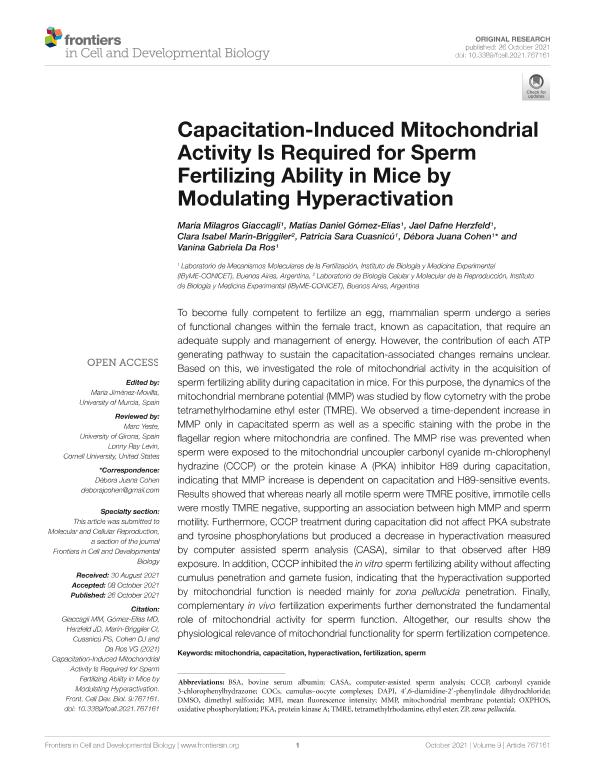Mostrar el registro sencillo del ítem
dc.contributor.author
Giaccagli, Maria Milagros

dc.contributor.author
Gómez Elías, Matías Daniel

dc.contributor.author
Herzfeld, Jael Dafne
dc.contributor.author
Marin Briggiler, Clara Isabel

dc.contributor.author
Cuasnicu, Patricia Sara

dc.contributor.author
Cohen, Debora Juana

dc.contributor.author
Da Ros, Vanina Gabriela

dc.date.available
2022-06-21T19:23:39Z
dc.date.issued
2021-10
dc.identifier.citation
Giaccagli, Maria Milagros; Gómez Elías, Matías Daniel; Herzfeld, Jael Dafne; Marin Briggiler, Clara Isabel; Cuasnicu, Patricia Sara; et al.; Capacitation-induced mitochondrial activity Is required for sperm fertilizing ability in mice by modulating hyperactivation; Frontiers Media; Frontiers in Cell and Developmental Biology; 9; 10-2021; 1-13
dc.identifier.issn
2296-634X
dc.identifier.uri
http://hdl.handle.net/11336/160107
dc.description.abstract
To become fully competent to fertilize an egg, mammalian sperm undergo a series of functional changes within the female tract, known as capacitation, that require an adequate supply and management of energy. However, the contribution of each ATP generating pathway to sustain the capacitation-associated changes remains unclear. Based on this, we investigated the role of mitochondrial activity in the acquisition of sperm fertilizing ability during capacitation in mice. For this purpose, the dynamics of the mitochondrial membrane potential (MMP) was studied by flow cytometry with the probe tetramethylrhodamine ethyl ester (TMRE). We observed a time-dependent increase in MMP only in capacitated sperm as well as a specific staining with the probe in the flagellar region where mitochondria are confined. The MMP rise was prevented when sperm were exposed to the mitochondrial uncoupler carbonyl cyanide m-chlorophenyl hydrazine (CCCP) or the protein kinase A (PKA) inhibitor H89 during capacitation, indicating that MMP increase is dependent on capacitation and H89-sensitive events. Results showed that whereas nearly all motile sperm were TMRE positive, immotile cells were mostly TMRE negative, supporting an association between high MMP and sperm motility. Furthermore, CCCP treatment during capacitation did not affect PKA substrate and tyrosine phosphorylations but produced a decrease in hyperactivation measured by computer assisted sperm analysis (CASA), similar to that observed after H89 exposure. In addition, CCCP inhibited the in vitro sperm fertilizing ability without affecting cumulus penetration and gamete fusion, indicating that the hyperactivation supported by mitochondrial function is needed mainly for zona pellucida penetration. Finally, complementary in vivo fertilization experiments further demonstrated the fundamental role of mitochondrial activity for sperm function. Altogether, our results show the physiological relevance of mitochondrial functionality for sperm fertilization competence.
dc.format
application/pdf
dc.language.iso
eng
dc.publisher
Frontiers Media

dc.rights
info:eu-repo/semantics/openAccess
dc.rights.uri
https://creativecommons.org/licenses/by-nc-sa/2.5/ar/
dc.subject
CAPACITATION
dc.subject
FERTILIZATION
dc.subject
HYPERACTIVATION
dc.subject
MITOCHONDRIA
dc.subject
SPERM
dc.subject.classification
Bioquímica y Biología Molecular

dc.subject.classification
Medicina Básica

dc.subject.classification
CIENCIAS MÉDICAS Y DE LA SALUD

dc.subject.classification
Biología Reproductiva

dc.subject.classification
Ciencias Biológicas

dc.subject.classification
CIENCIAS NATURALES Y EXACTAS

dc.title
Capacitation-induced mitochondrial activity Is required for sperm fertilizing ability in mice by modulating hyperactivation
dc.type
info:eu-repo/semantics/article
dc.type
info:ar-repo/semantics/artículo
dc.type
info:eu-repo/semantics/publishedVersion
dc.date.updated
2022-05-06T16:06:10Z
dc.journal.volume
9
dc.journal.pagination
1-13
dc.journal.pais
Suiza

dc.journal.ciudad
Basel
dc.description.fil
Fil: Giaccagli, Maria Milagros. Consejo Nacional de Investigaciones Científicas y Técnicas. Instituto de Biología y Medicina Experimental. Fundación de Instituto de Biología y Medicina Experimental. Instituto de Biología y Medicina Experimental; Argentina
dc.description.fil
Fil: Gómez Elías, Matías Daniel. Consejo Nacional de Investigaciones Científicas y Técnicas. Instituto de Biología y Medicina Experimental. Fundación de Instituto de Biología y Medicina Experimental. Instituto de Biología y Medicina Experimental; Argentina
dc.description.fil
Fil: Herzfeld, Jael Dafne. Consejo Nacional de Investigaciones Científicas y Técnicas. Instituto de Biología y Medicina Experimental. Fundación de Instituto de Biología y Medicina Experimental. Instituto de Biología y Medicina Experimental; Argentina
dc.description.fil
Fil: Marin Briggiler, Clara Isabel. Consejo Nacional de Investigaciones Científicas y Técnicas. Instituto de Biología y Medicina Experimental. Fundación de Instituto de Biología y Medicina Experimental. Instituto de Biología y Medicina Experimental; Argentina
dc.description.fil
Fil: Cuasnicu, Patricia Sara. Consejo Nacional de Investigaciones Científicas y Técnicas. Instituto de Biología y Medicina Experimental. Fundación de Instituto de Biología y Medicina Experimental. Instituto de Biología y Medicina Experimental; Argentina
dc.description.fil
Fil: Cohen, Debora Juana. Consejo Nacional de Investigaciones Científicas y Técnicas. Instituto de Biología y Medicina Experimental. Fundación de Instituto de Biología y Medicina Experimental. Instituto de Biología y Medicina Experimental; Argentina
dc.description.fil
Fil: Da Ros, Vanina Gabriela. Consejo Nacional de Investigaciones Científicas y Técnicas. Instituto de Biología y Medicina Experimental. Fundación de Instituto de Biología y Medicina Experimental. Instituto de Biología y Medicina Experimental; Argentina
dc.journal.title
Frontiers in Cell and Developmental Biology
dc.relation.alternativeid
info:eu-repo/semantics/altIdentifier/url/https://www.frontiersin.org/articles/10.3389/fcell.2021.767161/full
dc.relation.alternativeid
info:eu-repo/semantics/altIdentifier/doi/http://dx.doi.org/10.3389/fcell.2021.767161
Archivos asociados
